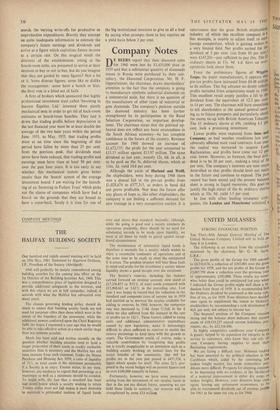Company Notes
E BEERS report that their diamond sales for 1960 were less by £1,435,000 than in 1959 and that a substantial quantity of diamonds mined in Russia were purchased by their sub- sidiary, the Diamond Corporation. Mr. H. F. Oppenheimer, the chairman, draws shareholders' attention to the fact that the company is going to manufacture synthetic industrial diamonds on a commercial scale, but there is no question of the manufacture of other types of industrial or gem diamonds. The company's position outside the diamond industry has been further strengthened by its participation in the Rand Selection Corporation, an important develop- ment. The chairman states that the political up- heaval does not reflect any basic unsoundness in the South African economy—he has complete confidence in the future of the country. Revenue account for 1960 showed an increase of £1,672,135; the profit for the year amounted to £15.15 million against £13.97 million. The same dividend as last year, namely 12s. 6d. in all, is to be paid on the 5s. deferred shares, which at 116s. 3d. yield 10.8 per cent.
Although the yards of Harland and Wolff, the shipbuilders, were busy during 1960 there was a dismal fall in the pre-tax profits from £1,028,674 to £377,315, as orders in hand did not prove profitable. Nor does the future offer any gleam of hope as, like other shipbuilders, the company is not finding a sufficient demand for new tonnage in a very competitive market. It is tg ai etl in
to t.) El
0- a
unfortunate that the great British shipbuildo industry of which this excellent company is fine example, is unable to adjust itself to me foreign competition, which is gaining orders a very limited field. Net profits earned for dividend of 5 per cent. (cut from 10 per cee were £147,241—just sufficient to pay this. The ordinary shares at 17s. 9d x.d. have an ova optimistic look about them.
From the preliminary figures of Wigg l'eape, the paper manufacturers, it appears tt pre-tax profits have increased from £4.48 milli to £6 million. This big advance no doubt retie profits included from acquisitions made in 191 This excellent result amply justifies a lift in t dividend from the equivalent of 12.3 per Cel to 14 per cent. The chairman will have somethi to tell shareholders at the annual general me ing as to future prospects and particularly abc the recent tie-up with British American Tobao The £1 ordinary shares at 69s. yielding 4.1 r cent. look a promising investment Lower profits were expected from Inns a Company, as bad weather conditions last y adversely affected most road contracts. Last y the capital was increased to acquire La Reclamation, and profits have come out 12 cent. lower. However, as forecast, the final di dend is to be 20 per cent., making a total of per cent. The company's interests are now rra diversified so that profits should level out im in the future and continue to expand. The p record has been sound and the present balar sheet is strong in liquid resources; this goes justify the high status of the 4s. ordinary sha which at 33s. 9d. yield 3.5 per cent.
In line with other leading insurance co panics, the London and Manchester achieved ins at on Is 0. he t. ng
at o. er
nd ear ear nd per vi- 30 re re ast ea to es
big expansion in their life branches in 1960. Total life income rose by £11 million to £131 million and funds by £5 million to £11 million. A year ago a scrip issue of one-for-one was made; now the dividend is stepped up to 2s. 81d. tax free compared with the equivalent of 2s. 41d. in 1959 Expansion has taken place mainly in the ordinary life branch where premium income rose by £1 million to £8 million and by £1 million in respect of the unique investment trust retire- ment annuities branch. Profit and loss account bad a total favourable balance of £268,000; the dividend takes £266,000. The 5s. ordinary shares have moved steadily upwards with the rest of the insurance market and are now 182s. 6d. yielding 2.4 per cent.







































 Previous page
Previous page